|

 Explorers, Scientists &
Inventors
Explorers, Scientists &
Inventors
 Musicians, Painters &
Artists
Musicians, Painters &
Artists
 Poets, Writers &
Philosophers
Poets, Writers &
Philosophers
 Native Americans & The Wild
West
Native Americans & The Wild
West
 First Ladies
First Ladies
 Popes
Popes
 Troublemakers
Troublemakers
 Historians
Historians
 Archaeologists
Archaeologists
 Royal Families
Royal Families
 Tribes & Peoples
Tribes & Peoples

Assassinations in History
Who
got slain, almost slain, when, how,
why, and by whom?
 Go to the
Assassination Archive
Go to the
Assassination Archive

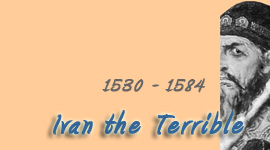


Online History Dictionary A - Z
All-Time Records in
History
What was the
bloodiest battle, the battle with the least
casualties, who was the greatest military leader?
 Go to
Records in History
Go to
Records in History
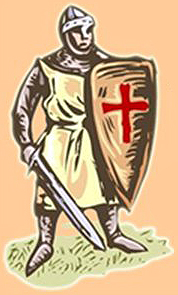
|
|
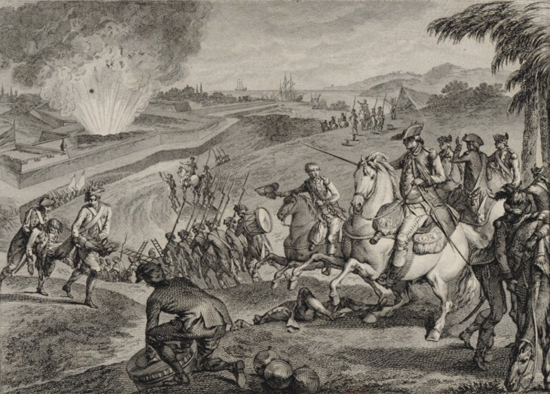
The Spanish Take
Pensacola From the
British
Siege of Pensacola 1781
The Siege of Pensacola was part of
the
 American
Revolution and tends
to be underreported because no American
troops were involved.
American
Revolution and tends
to be underreported because no American
troops were involved.
|
|
Image Above
The
Capture of Pensacola
This engraving illustrates the events from Tuesday, May 8, 1781, at 9:30 A.M.
when a Spanish grenade hit the magazine of
the half-moon shaped British outwork, called the Queen's Redoubt.
On
horseback in the foreground on the right is
Bernard Galvez, commander in chief of the Spanish
army.
Scroll down for more about this image.
Engraving by Nicolas Ponce (1746-1831)
Bibliothèque nationale de France
Who Fought?
The Spanish and the French
(approx. 8,000 troops)
Led by Governor of Louisiana Bernardo de Gálvez
vs.
The British
Alongside, and on the British payroll, fought
Germans from Waldeck, a few Americans,
over 300 Indians, and "many negroes."
(all in all approx. 2,000 defenders of Fort George)
Led by major-general John Campbell,
who commanded his Fifty-seventh Regiment of Foot
Pensacola was the capital of
 West Florida.
West Florida.
Governor of West Florida was Peter Chester
(since December 1769)
|
When Did the Siege of
Pensacola Begin?
When Did It End?
The Siege of Pensacola begun on March
9, 1781, when the first Spanish ships arrived off Santa Rosa
Island (see map below.)
It ended on May 10, 1781, when the
British troops evacuated the fort and handed over their arms.
Location, Size, and
Layout of Pensacola
Pensacola, the
capital of British West Florida, had about 200 houses and was
defended by Fort George.
The fort overlooked the town and had two outworks,
called the Queen's
Redoubt and the Prince of Wales' Redoubt.
To get into Pensacola Bay, one had
to pass the Red Cliffs battery, later Fort Barrancas.
Here is the map

Map location of Fort George, Red Cliff Fort (later Fort Barrancas)
that overlooked the entrance of Pensacola Bay, and Santa Rosa Island
On Modern Google Map
Events Preceding the
Siege of Pensacola
In 1775, the map looked like this:
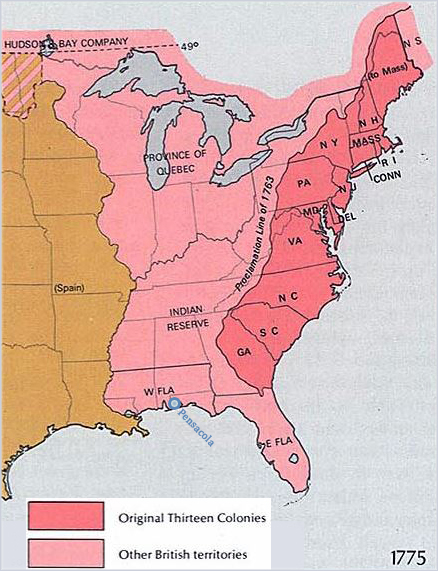
Map 1775: Original Thirteen Colonies, Other British Territories,
Spanish Possessions
 Click to view 14 maps illustrating U.S.
territorial growth
Click to view 14 maps illustrating U.S.
territorial growth
France joined the American Revolution when it declared war on
Britain in 1778. Spain followed suit in 1779.
On March 14, 1780, the Spanish defeated the British and captured Fort Charlotte (formerly
French Fort Conde) in today's downtown Mobile (Movila),
Alabama.
Early in 1781, a Spanish unit sailed from Havana, a second from New
Orleans, and a third advanced from Mobile, all with Pensacola on
their GPS.
The Siege of Pensacola
- A Brief Timeline
Part of this timeline is taken from the diary of Francisco de Miranda,
a Spanish
officer with Venezuelan roots, who arrived at Pensacola with the expedition
that sailed from Havana.
|
March
9, 1781 |
The Siege
of Pensacola Begins
The first Spanish squadron arrives
off Santa Rosa Island at the
entrance to Pensacola Bay.
|
|
March 18, 1781 |
Galvez lands at Pensacola.
|
|
April
9, 1781 |
Another Spanish reinforcement from
Havana, led by Josef Solano and Manuel de Cagigal,
arrives off Pensacola.
Altogether the Spanish forces number
now some 7,224 officers and
men.
|
|
April
12, 1781 |
Galvez wounded
|
|
April
19, 1781 |
A French squadron
arrives with 725 men.
|
|
May 5, 1781 |
A gale had blown the Spanish fleet
away from the Gulf coast, but it
recovered.
Starting today, and for six days
straight during all hours of
daylight, the Spanish will batter
the fort with 8
twenty-four pounders and several
large mortars.
|
|
May 8, 1781 |
The British
Queen's Redoubt blows up
The fire of the British batteries
had continued with the same degree
of activity and accuracy as the
preceding days. It caused sufficient
damage in the Spanish trench on
which the Spanish had at last
succeeded in speeding up the work.
9.30 AM: The Spanish heard from the
camp a great explosion which alarmed
them generally without them being
able to ascertain the danger. The
Spanish major-general went
immediately to the section of the
trench from which the noise was
heard, and they saw a great column
of smoke rising toward the clouds,
and later the Spanish found out that
the explosion had been inside the
circular fort,
which battery was all in flames, and
was caused by a grenade from the
Spanish howitzers.
The Spanish
general and chief's present (leaving
the camp in charge of General Cagigal), went immediately with some
troops to the trench and assured
themselves of the effect by sight of
the damage.
The Spanish troops
advanced under command of Brigadier Giron through the left branch and
under cover of the same battery that
was burning.
Fort George
surrenders
3 PM: The British in Fort George
raised the white flag and some
officers advanced to confer over
capitulation. General Galvez
attended personally and the
conference lasted until 11 at night.
The Spanish later found out that 108
of the British best troops and two
marines were blown up in the
redoubt.
|
|
May 9, 1781 |
7 AM: Sergeant Major Campo came to
the Spanish camp with full authority
to complete the capitulation. By 2
PM everything was finished, the
Spanish conceding to the guard the
honors of war.
3.30 PM: General Galvez, with two
companies of grenadiers, went to
take possession of the city and was
very well received by the people of
the vicinity.
|
|
May
10,
1781 |
On this day the Spanish generals and
their aides-de-camp remained housed
in the city.
3 PM: General Galvez and 6 companies
came to take possession of the fort.
The guards came out, and in forming
at a distance of 150 meters from the
fort, gave up their flags and arms
to the Spanish troops which were
formed in front of them. The guards
were relieved consecutively of the
surrendered forts, lowering the
British flag and raising that of
Spain.
The
British troops left the fort and
handed over their arms.
The
Siege of Pensacola Ends. |
Casualties
The Spanish and French suffered almost 300 casualties. Army: 75
killed, 198 wounded. Navy: 21 killed, 4 wounded.
British losses: 105 blown up in the crescent, 56 deserters during
the siege, 300 who whilst the capitulation was being drawn up
retired to Georgia
Total number of prisoners: 1,113
More About Fort George
The Spanish renamed it Fort San Miguel. Nothing's left of it today,
but you can visit Fort George Park on the corner of Palafox and La Rua
in Pensacola.
Find more at
 FortWiki
FortWiki
More About the Image
Above
From the French National Library. The entire page looks like this:
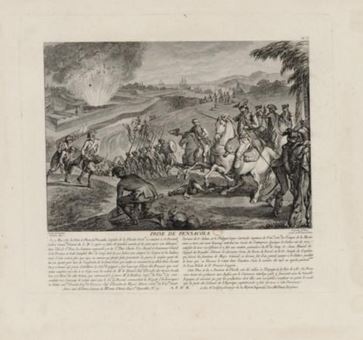
Prise de Pensacola - Capture of Pensacola
Gallica.bnf.fr
Under the image it reads:
Prise de Pensacola
Le 9 Mai 1781, les Forts et Places de Pensacola, Capitale de la
Floride Occidentale se rendent à Don Bernard Galvez Commandant l'Armée de
S.M.C. [Su Majestad Cristianísima] après 12 jours de tranchée ouverte, et 61 jours après son
debarquement dans l'Isle de Ste Rose.
La Garrison commandée par les
Sieurs Peter Chester Vice-Amiral et Gouverneur Général de la Province,
et Ionh Campbel Marechal de Camp, étoit de 1,700 hommes non compris
les Negres et les Indiens; mais il n'en restoit plus que 1,400 ou
environ qui furent faits prisonniers de guerre, le surplus ayant été
tué, ou ayant peri lors de l'explosion de la Demi-Lune qui sauta au
moment ou on alloit donner l'assaut. On y a trouvé 193 pieces
d'Artillerie.
Le General Espangnol a fait beaucoup d'éloges des
François qui sont venus coopérer avec lui à ce Siège, sous les
ordres de Monsieur de Monteil, Chef d'Escadre des Armées Navales.
Les 700 Hommes de cette Nation, que commandoit à terre Monsieur de
Botderu Capitaine de Vaisseau s'y sont conduits avec beaucoup de
valeur ainsi que le Chevalier de Ravenel commandant la Frégate
l'Andromaque.
D. Solano com'de l'Escadre Espagnole, D. Thomaseo Chef
d'Escadre, D. Miguel Alderete comm'dt les Vaisseaux avant l'arrivée
de D. Solano, et D. Philippes Lopez Carrizola Capitaine de Vaisseau
Comm'dt les Troupes de la Marine mises a terre, ont aussi beaucoup
contribué au succès de l'entreprise.
Quoique D. Galvez ait été très
satisfait de tous ses Officiers, il a fait une mention particuliere
du Marechal de Camp D. Juan Manuel de Cagigal, du Brigadier d'Armée
D. Géronimo Giron, du Baron de Kessel, et de D. Joseph de Expélata
qui faissoit les fonctions de Major Général; ce dernier fut d'un
grand secours à D. Galvez pendant le temps que sa blessure le retint
dans l'inaction. Dans le nombre des tués on regrète particulierement
D. Louis Rebolo et D. François Longaria.
Cette Place et les 2 Provinces de Floride ont été cédèes à l'Espagne
à la Paix de 1783. Ces Possessions étient très prètieuses aux
Anglois par le Commerce interlope quils y faisoient avec la Nouvelle
Espagne, et auroient pu, par les productions dont elles sont
susceptibles, remplacer en partie le vuide que la perte des Colonies
de l'Amerique septentrionale a fait éprouver à cette Puissance.
In other words:
Capture of Pensacola
On
May 9, 1781, the forts and venues of Pensacola, capital of West
Florida, fell to Don Bernardo Galvez,
commander of the Army of His Most Christian
Majesty, 12 days after trenches were opened,
and 61 days after his landing on Santa Rosa
Island.
The garrison under the command of Peter Chester,
vice admiral and governor of the province, and Ionh Campbel,
marechal de camp, consisted of 1,700
men, not including the Negroes and Indians; but it
didn't remain more
than 1,400 or so which were made prisoners of war, the rest
was killed or perished in the explosion of the Half Moon which blew
up at the moment of our attack. We found 193
pieces of artillery.
The
Spanish general gave much praise to the French who, under the
command of Mr de Monteil, chef d'escadre
of the navy, came and assisted him at this
siege. The 700 men of this nation, ashore
under the command of Captain Botderu and the Chevalier de Ravenel,
captain of the frigate L'Andromaque,
acted with much bravery.
Don Solano
leading the Spanish wing, Don Thomaseo Chef
d'Escadre, Don Miguel Alderete commanding the vessels before Don
Solano's arrival, and Captain Don Philippes Lopez Carrizola
commanding the navy troops on shore, also
contributed considerably to the success of
this enterprise.
Although Don Galvez was very pleased with all his officers,
he made particular mention of the Marechal de Camp Don Juan Manuel
de Cagigal, of the Brigadier d'Armée Don Geronimo Giron, of Baron de Kessel,
and of Don Joseph Expélata who acted as Major Général; the
latter was of great help to Don Galvez during the time
when his injury
kept him immobilized. Among the fallen we mourn in particular Don Louis Rebolo and Don François Longaria.
This
town and the two provinces of Florida were
ceded to Spain with the Peace of 1783. These
possessions were very valuable to the English
for their illegal trade with New Spain,
and could have, with the output of which they are capable, replaced in part the
void that that power suffered from the loss
of the North American colonies.
More
 here.
here.
More Maps

Acquisition of West Florida 1767-1819
Click to enlarge

The Floridas - East and West Florida
1765
Click to enlarge
Last Map
A different map from Florida's State Archives:
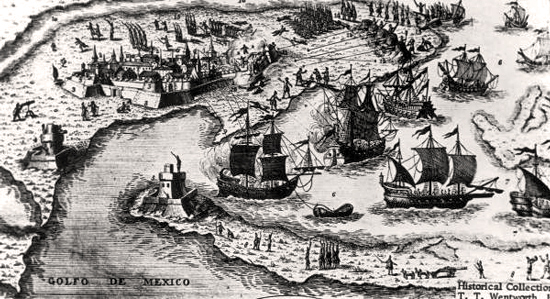
Battle of Pensacola
Imaginative engraving of the 1781 Battle of Pensacola
State Archives of Florida
See more under
 History of West Florida
History of West Florida
More History
|